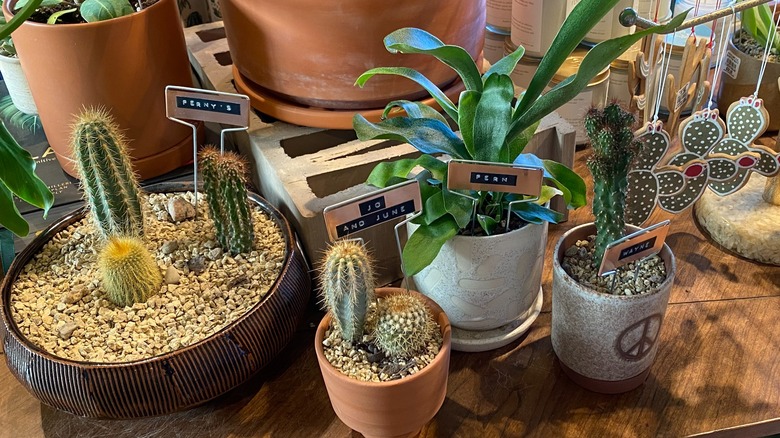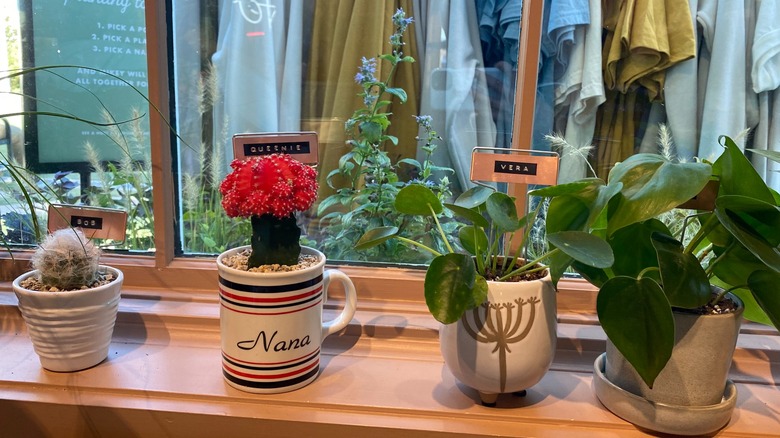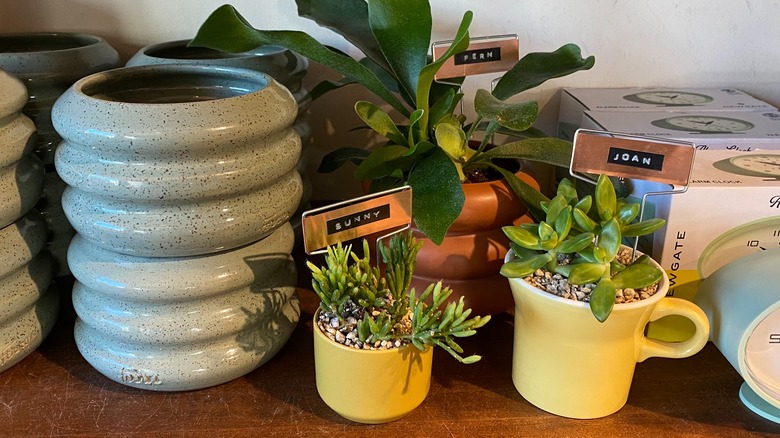Ferny's At Magnolia Tells Us How To Create Drainage In Houseplant Pots With Zero Drilling
Water is essential for all plants to thrive. However, watering houseplants is a balancing act. Too little, and they can shrivel and brown. Too much, and their roots can drown. Many planters and pots have drainage holes already in the bottom. And for some containers, you can drill a hole if they don't already come with them. But, what happens if you fall in love with a pot you can't or don't want to drill holes in? Justine Lisa, design coordinator at Ferny's: The Retro Plant Shop, has a quick tip. "A lot of our vintage [pots], actually, don't have drainage holes," Justina Lisa explains in an exclusive interview with House Digest. "And the reason being is that we don't want to drill into the vintage pot just in case it breaks. But if your... pot doesn't have drainage, if you put a layer of rock or a layer of, like, shale at the bottom to create that drainage, that'll just be fine."
The pots at Ferny's often include vintage options and irreplaceable coffee mugs. Trying to drill a hole in the bottom to create drainage puts those pots at risk of cracking or breaking, losing a one-of-a-kind planter. But adding a layer of rock at the bottom of the pot allows the water to drain away from the roots, helping to prevent potentially fatal root rot and protecting the integrity of these unique vintage pieces.
The dangers of sitting water
Plants need water for photosynthesis and to transport nutrients from the soil to the plant body. However, too much water poses an issue to the health and integrity of plants. Soil can hold onto water, so if there is nowhere for the water to go when you water your plants, the soil will retain it. Roots of overwatered plants have a difficult time absorbing oxygen, effectively suffocating a plant. Too much water can also cause mold and fungi growth, which causes root rot.
Having a place for the water to flow away from the roots is essential in keeping the soil at a healthy moisture level. This is usually accomplished with drainage holes, which allow the water to flow out of the vessel. However, not every container comes with holes, and some aren't able to have holes drilled in them, like the antiques and mugs offered at Ferny's Retro Plant Shop. This is where alternative forms of drainage come into play. As Justina Lisa suggests, a layer of rock at the bottom of the planter can help keep water away from roots and from oversaturating the soil.
Creating adequate drainage
Adding rocks to the bottom of pots, as suggested by Justina Lisa of Ferny's Retro Plant Shop, is one way to promote excess drainage for pots without a hole. Plus, there are many other ways to maintain a proper moisture level. Give your store-bought soil a boost by creating a custom mixture with perlite and vermiculite, which help break up dense soil and add air pockets that deliver oxygen to plant roots. You could also use potting soil specifically made to maintain proper moisture levels.
If you have a pot without drainage holes, another option is to use a plastic nursery pot along with the decorative pot. Plant the soil and plant in the plastic nursery and place the nursery pot inside the decorative piece without drainage holes. With this method, you can remove the decorative pot to dump out any excess water without digging up your plant. You can also use a pot without drainage holes with plants that don't need a lot of water or watering often, like succulents and cacti, rather than tropical varieties. This will ensure any excess water is absorbed or dried out before you have to water that plant again.


